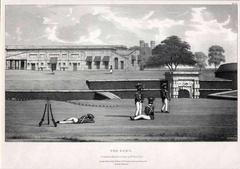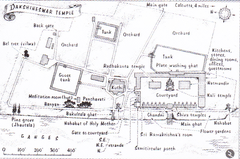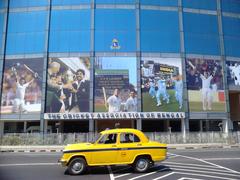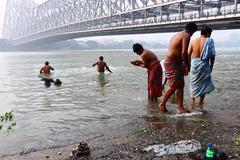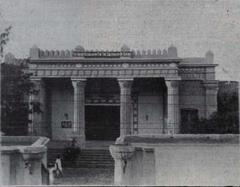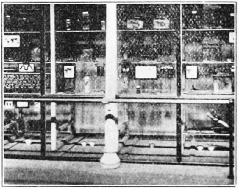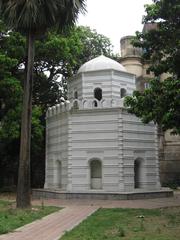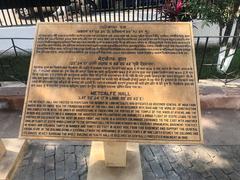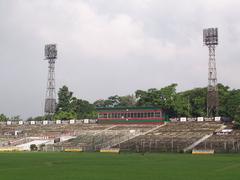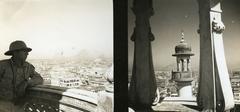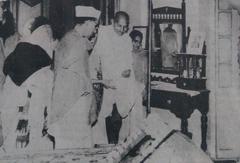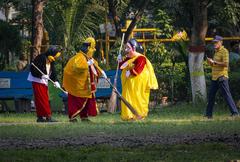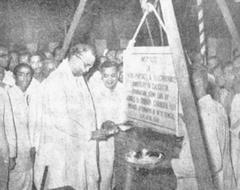
Comprehensive Guide to Visiting Fort William, Kolkata
Date: 17/07/2024
Introduction
Fort William in Kolkata, previously known as Calcutta, stands as an enduring symbol of India’s colonial history. This imposing structure, located on the eastern banks of the Hooghly River, has witnessed pivotal moments in India’s past, from the establishment of British trade in the 17th century to the transfer of power to the Indian government. Built initially by the British East India Company in the late 17th century and later reconstructed in the mid-18th century, Fort William has been a central figure in various historical events, including the infamous Black Hole of Calcutta and the Battle of Plassey (source). Today, Fort William is managed by the Indian Army and serves as the headquarters of the Eastern Command, making it a site of both historical and contemporary significance. Visitors can explore certain sections of this grand fortress through guided tours, offering a unique glimpse into the colonial era and its lasting impact on the region. This guide provides comprehensive information on Fort William’s history, visiting hours, ticketing, and nearby attractions to help you plan your visit effectively.
Table of Contents
- [Introduction](#introductionintroduction)
- [Early Fortification and the Birth of Calcutta](#early-fortification-and-the-birth-of-calcuttaearly-fortification-and-the-birth-of-calcutta)
- [The Siege of Calcutta and the Black Hole Tragedy](#the-siege-of-calcutta-and-the-black-hole-tragedythe-siege-of-calcutta-and-the-black-hole-tragedy)
- [Reconstruction and the Rise of a Colonial Bastion](#reconstruction-and-the-rise-of-a-colonial-bastionreconstruction-and-the-rise-of-a-colonial-bastion)
- [Fort William as the Seat of Power](#fort-william-as-the-seat-of-powerfort-william-as-the-seat-of-power)
- [Transfer of Power and Present-Day Significance](#transfer-of-power-and-present-day-significancetransfer-of-power-and-present-day-significance)
- [Visitor Information](#visitor-informationvisitor-information)
- [Fort William Visiting Hours](#fort-william-visiting-hoursfort-william-visiting-hours)
- [Fort William Tickets](#fort-william-ticketsfort-william-tickets)
- [Accessibility](#accessibilityaccessibility)
- [Travel Tips and Nearby Attractions](#travel-tips-and-nearby-attractionstravel-tips-and-nearby-attractions)
- [Best Time to Visit](#best-time-to-visitbest-time-to-visit)
- [Nearby Attractions](#nearby-attractionsnearby-attractions)
- [Photography](#photographyphotography)
- [FAQ](#faqfaq)
- [Conclusion](#conclusionconclusion)
- [Call to Action](#call-to-actioncall-to-action)
Early Fortification and the Birth of Calcutta
The story of Fort William is intricately woven with the very foundation of Kolkata. The fort’s genesis can be traced back to the late 17th century, during the nascent years of the British East India Company’s presence in India. Job Charnock, an agent of the company, established a trading post in the village of Sutanuti in 1690. Recognizing the strategic importance of the location for trade and defense, the company sought permission from the Mughal Emperor Aurangzeb to fortify their settlement.
In 1696, the Mughal authorities granted permission, and the construction of the original Fort William commenced. This initial fort, named after King William III of England, was a modest structure compared to its later incarnation. It consisted of a fortified factory, warehouses, and accommodations for the company’s factors (traders). This marked the formal establishment of Calcutta, which rapidly grew around the fort, transforming from a humble village into a bustling trading hub.
The Siege of Calcutta and the Black Hole Tragedy
The early 18th century witnessed the waning power of the Mughal Empire and the rise of regional powers. In Bengal, Nawab Siraj ud-Daulah viewed the growing influence and fortification of the British with suspicion. In 1756, he attacked and captured Fort William, marking a dark chapter in the fort’s history.
The captured British defenders and some Indian civilians were imprisoned in a cramped guardroom within the fort, infamously known as the ‘Black Hole of Calcutta.’ The suffocating conditions of the overcrowded cell led to the deaths of many prisoners. While the exact number remains a subject of historical debate, the incident became a potent symbol of British humiliation and fueled their desire for revenge.
Reconstruction and the Rise of a Colonial Bastion
Following their victory in the Battle of Plassey in 1757, where Robert Clive led the British East India Company forces to defeat Siraj ud-Daulah, the British regained control of Calcutta. The ruined Fort William was deemed inadequate for the company’s growing military and administrative needs. Consequently, under the supervision of Robert Clive himself, the reconstruction of the fort began in 1758.
This time, the fort was designed on a much grander scale, incorporating the latest European military architectural principles. The new Fort William, completed in 1781, was a formidable star-shaped fortress, boasting six massive gates, numerous bastions, and the capacity to house a garrison of 10,000 soldiers. The fort’s construction consumed a staggering sum of money, reflecting its importance as the center of British power in India.
Fort William as the Seat of Power
For over a century, Fort William served as the nerve center of British administration in India. It housed the offices of the Governor-General of Bengal, later the Viceroy of India, and various other important administrative departments. The fort’s imposing presence symbolized British dominance and served as a constant reminder of their military might.
Life within the fort’s walls was a microcosm of colonial society. While British officers and administrators enjoyed luxurious lives, Indian soldiers, servants, and laborers formed the backbone of the fort’s functioning. The fort’s history is thus also a testament to the complex social hierarchy and power dynamics that characterized the colonial era.
Transfer of Power and Present-Day Significance
The Sepoy Mutiny of 1857, though centered in North India, had a profound impact on the British Raj. Following the uprising, the British Crown assumed direct control of India from the East India Company. In 1858, the administration of India was transferred to the British government, and Fort William’s role as the center of power gradually diminished.
Today, Fort William is no longer the seat of national administration. It is maintained by the Indian Army and houses the Eastern Command headquarters. While large sections of the fort remain out of bounds for the general public due to security reasons, certain areas are open for guided tours.
Visitor Information
Fort William Visiting Hours
- Visiting Hours: 10:00 AM - 5:00 PM (Monday to Friday)
- Closed: Weekends and Public Holidays
Fort William Tickets
- Entry Fee: Free (Guided tours may have separate charges)
- Tour Bookings: Available through official channels or authorized tour operators
Accessibility
- Wheelchair Accessible: Yes
- Restrooms: Available
- Parking: Limited parking available near the fort premises
Travel Tips and Nearby Attractions
Best Time to Visit
- Best Time to Visit: October to March for pleasant weather
Nearby Attractions
- Victoria Memorial: A stunning white marble monument dedicated to Queen Victoria, housing a museum showcasing Kolkata’s history (Victoria Memorial Website).
- St. Paul’s Cathedral: An example of Indo-Gothic architecture, featuring intricate stained glass windows and peaceful gardens (St. Paul’s Cathedral Website).
- Indian Museum: The oldest and largest museum in India, featuring diverse collections spanning art, archaeology, anthropology, geology, and zoology (Indian Museum Website).
- Maidan: A vast green expanse ideal for leisurely walks, picnics, and horse-drawn carriage rides.
Photography
- Photography: Allowed in certain areas; check with your guide
FAQ
Q: Is Fort William open to the public? A: While large sections are restricted due to security reasons, guided tours are available to certain areas.
Q: Are there any special events held at Fort William? A: The fort occasionally hosts military events and ceremonies. Check with local guides or official websites for updates.
Q: Can I take photographs inside Fort William? A: Photography is allowed in designated areas. It’s best to confirm with your tour guide.
Conclusion
Fort William is not just a historical monument; it is a living relic of India’s colonial past. Whether you’re a history enthusiast or a casual traveler, a visit to Fort William offers a unique glimpse into the rich tapestry of Kolkata’s history. Be sure to plan your visit, check the official guidelines, and immerse yourself in the stories etched in every brick and mortar of this magnificent fort.
Stay updated with our latest posts, download our mobile app Audiala, and follow us on social media for more historical insights and travel tips.
References
- Britannica, 2021, Editors Fort William
